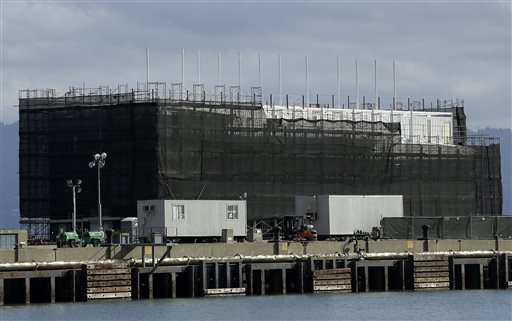San Francisco's mayor says he doesn't know what it is. Police say it's not their jurisdiction. And government inspectors are sworn to secrecy.
Google is erecting a four-story structure in the heart of the San Francisco Bay but is managing to conceal its purpose by constructing it on docked barges instead of on land, where city building permits and public plans are mandatory. Construction became obvious a few weeks ago.
The Internet giant's actions at Treasure Island appear legal. But the mystery surrounding the bulky floating building - and a similar one off Portland, Maine - is generating rumors and worries.
Privacy experts, environmentalists and legal authorities say that whether it is a store to sell Google's Internet-connected glasses, a data storage center or something else, the secrecy may backfire because Silicon Valley residents are highly protective of one of the most scenic and environmentally sensitive bays in the U.S.
"At some point they're going to have to unveil what it is they're doing, and it will be sad if they have put a lot of money into something that is simply not allowable in the bay," said Deb Self, executive director of the environmental group Baykeeper.
Self said whether the barge-mounted structure is a store, as is widely rumored, or a data center powered by wave action, for which Google has a patent, there are going to be grave concerns.
"We don't really want to see the bay used as a shopping mall. Unacceptable," she said. And environmentalists warn that water-cooled data centers might warm the sea and harm marine life.
Google's usually responsive media relations team has not responded to repeated calls or emails over several days, but records and other official accounts identify the project as Google's.
Google has dodged public scrutiny by essentially constructing a vessel, not a building. Thus it doesn't need permits from San Francisco, a city with copious inspection and paperwork requirements for builders.
Google has also avoided the San Francisco Bay Conservation and Development Commission, a state agency that governs projects on the water and has its own long list of public reviews and permit requirements.
If, when the project's ready, Google wants to sail it out the Golden Gate and into the Pacific Ocean, the tech giant won't ever need to explain what it's been up to.
But if Google wants to do anything with the structure in the bay, it will have to face public scrutiny, said BCDC executive director Larry Goldzband. He said the agency has had a few meetings with Google, but "they've been less than specific about their plans."
"When they decide to let us know what they plan to do with it, or hope to do with it, then we can decide if it's allowable," he said.
Work on the barge is kept under wraps, literally. Supplies are kept onshore in hangars rented by a Delaware corporation named By and Large, (a play on the word "barge"?), under a $79,000-per-month lease that expires next August.
The name and number for By and Large on the lease led to a man named Mike Darby, who seemed baffled by a call from The Associated Press. "I'm not sure how my name got on the lease," he said. "I have nothing to do with it. I'm in Singapore and it's the middle of the night."
A second man on the lease, Kenneth Yi, could not be located.
There is one agency keeping an eye on things: The Coast Guard has been routinely inspecting the two barges on the East and West coasts, as it would any vessel under construction, but spokeswoman Lt. Anna Dixon said she couldn't talk about what the agency has found, citing nondisclosure agreements with an entity other than Google.
Such agreements, she said, are "not a standard practice" at her agency. She said she didn't know the name of the entity.
A similar four-story structure was built this summer in the New London, Conn., harbor, and has now moved north off Maine. The Day newspaper in Connecticut found details tying that barge to Google in documents obtained through a Freedom of Information Act request.
Santa Clara University law professor Dorothy Glancy said nondisclosure agreements involving inspectors are common for land-bound Silicon Valley construction projects because there are plenty of trade secrets in the clean rooms and laboratories where computer chips are built and technology is developed.
But she said Google might want to take a lesson from another bay-area mystery barge. In the 1970s, billionaire Howard Hughes docked an enormous barge called the Glomar Explorer just off Mountain View, Calif., where Google is now headquartered. Hughes said the Glomar was going to mine manganese from the ocean floor, but in reality it was being used for a top-secret CIA mission to search for nuclear missile codes in sunken Soviet submarines.
"That experience should have told Google that being mysterious like this tends not to build public confidence," Glancy said.
Privacy advocate Jamie Court, president of Consumer Watchdog, said it is ironic that the company that wants to open the world's information to everyone "so zealously guards its own corporate secrecy."
"The barge is a perfect metaphor for a company that likes to ask forgiveness for its transgressions rather than permission," he said. "It's also a symbol of how far from mainland values the company is going with Glass and its privacy problems."

